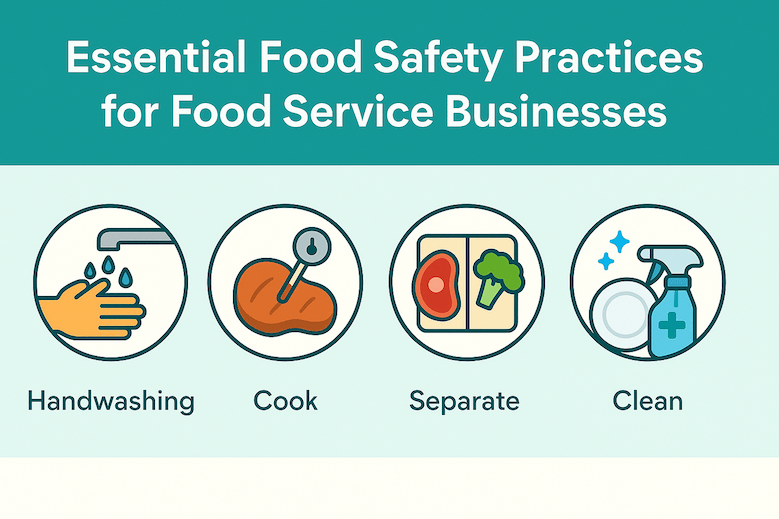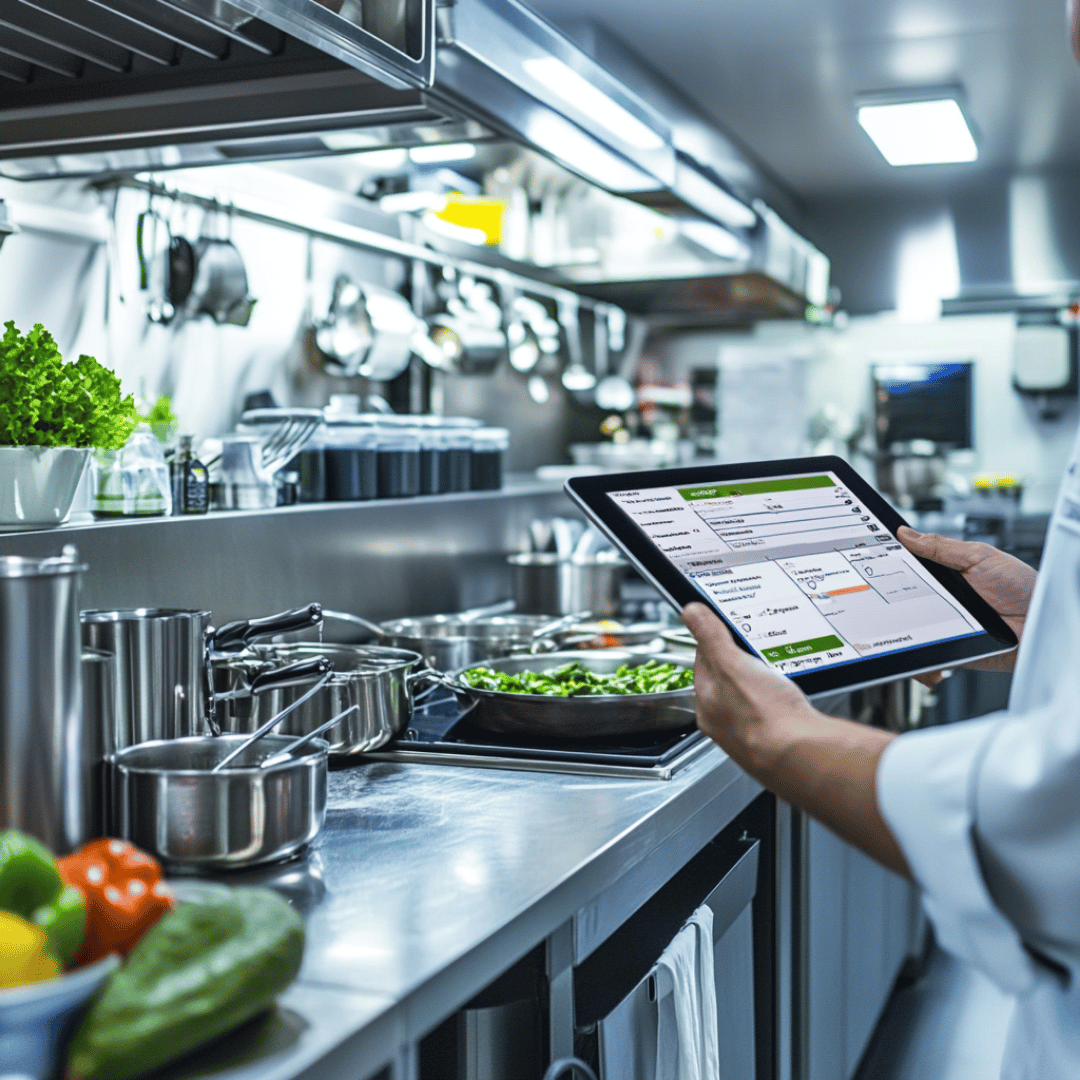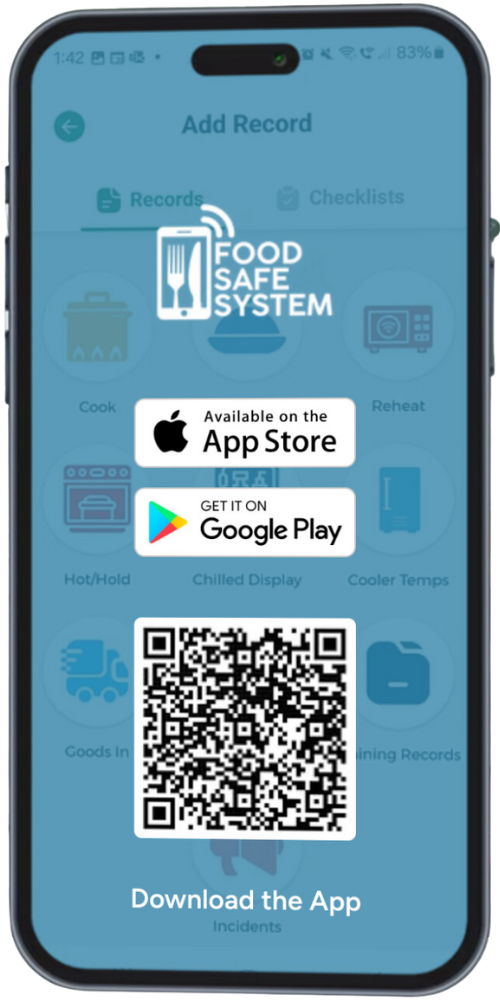Written by FoodSafeSystem
Thursday, May 15

Discover how switching from manual to digital food safety logging can protect your restaurant from devastating FSA fines while saving time and ensuring perfect compliance records.
The health inspector arrived unannounced on what was already James Whitley’s worst day in five years of running his Brighton seafood restaurant. His head chef had called in sick, a refrigeration unit was acting up, and now this, a surprise inspection from the Food Standards Agency during the lunch rush.
“When she asked to see our temperature logs and HACCP records, I felt physically ill,” James recalls. “We’d been busy, staff had been cutting corners on the paperwork, and I knew immediately we were in trouble.”
Three weeks later, James was facing a £7,500 fine and a devastating 2 star food hygiene rating that would take months to recover from. “The worst part is that we actually were following proper food safety protocols—we just couldn’t prove it because our documentation was incomplete.”
James isn’t alone. Every year, thousands of UK restaurant owners face similar scenarios, not because they’re deliberately cutting corners on food safety, but because of an outdated, error prone system that’s failing them: paper based food safety logs.
The Hidden Compliance Crisis in British Restaurants
The UK Food Standards Agency conducted over 86,000 food hygiene interventions last year alone. Of the businesses requiring major improvements, incomplete or inaccurate documentation was cited in 68% of cases—meaning the actual food handling might have been acceptable, but the paperwork wasn’t there to prove it.
Lost temperature logs. Missing delivery inspections. Incomplete staff training records. These paperwork failures resulted in an estimated £14.2 million in fines across the hospitality sector last year, according to industry data—most of which could have been avoided entirely.
The irony is striking: restaurant owners are spending more time than ever on compliance paperwork, yet failing inspections at alarming rates. The system is broken on both ends—demanding extensive documentation while making that documentation nearly impossible to maintain perfectly under real-world restaurant conditions.
When Sarah Holden, a compliance specialist who works with restaurants across the UK, examines documentation before mock inspections, she finds the same pattern repeatedly: “There’s almost always a two-week period where someone forgot to fill in the logs, usually during a busy holiday period or when key staff members were out. Those gaps are exactly what inspectors look for, and they’re almost inevitable with paper systems.”
Most food safety failures in the UK are due to paperwork errors rather than unsafe food.
New data reveals that 68% of major food safety issues in UK hospitality businesses stem from missing or incorrect documentation—not actual food handling problems. Incomplete logs, forgotten records, and lost inspections are costing the industry over £14 million in avoidable fines.
Why Your Kitchen Might Be Clean—but Still Failing Inspections
Restaurants are passing the hygiene test but failing the paperwork. Compliance specialists say gaps in logs, especially during busy periods, are the most common reason businesses fail inspections. Paper based systems can’t keep up with real world pressure.
The Hidden Cost of Paper Logs: £14.2 Million in Fines
Outdated documentation methods are quietly draining the UK hospitality sector. Despite best efforts, paper logs often go incomplete, leading to fines, failed inspections, and reputational damage. It’s not a food safety issue, it’s a systems issue.
The Hidden Compliance Crisis in British Restaurants
The immediate financial penalty from an FSA fine, typically ranging from £1,000 to £20,000 depending on the severity and size of the operation, is just the beginning of the financial damage from poor compliance documentation.
For James Whitley’s seafood restaurant, the £7,500 fine was actually the smallest part of the financial impact.
“The drop in our hygiene rating cost us about 30% of our bookings over the next three months. We’re talking about nearly £45,000 in lost revenue before we could get reinspected and restore our rating.”
Then there are the secondary costs: increased insurance premiums following compliance failures, emergency staff training, consultant fees for compliance remediation, and the opportunity cost of management time devoted to addressing the issues rather than growing the business.
Financial services firm Deloitte estimates that for every £1 of regulatory fines in the hospitality sector, businesses incur an additional £3 to £5 in related costs and lost revenue—making the true cost of Britain’s restaurant documentation crisis closer to £70 million annually.
The psychological toll shouldn’t be overlooked either. Restaurant owners report that compliance anxiety ranks among their top sources of work-related stress, with 72% reporting they “frequently worry” about surprise inspections revealing documentation gaps they know probably exist somewhere in their records.
Why Traditional Documentation Fails Even Careful Operators
The fundamental problem with paper-based food safety systems isn’t the restaurant teams—it’s the approach’s inherent limitations. The typical restaurant requires 15-25 daily checks across refrigeration temperatures, hot-holding equipment, delivery inspections, sanitising procedures, allergen controls, and more.
These checks must happen during the busiest periods of restaurant operation, precisely when staff have the least time to step away and complete paperwork. The result is predictable: checks get done hastily, recorded later from memory (often inaccurately), or missed entirely during peak periods.
Neil Bradley explains: “When you’re in the middle of service and need to check six refrigeration units, record the temperatures, then document any corrective actions for units outside the safe zone—all while tickets are piling up and food needs to go out—something has to give. Unfortunately, it’s usually the documentation.”
Even when records are maintained diligently, paper systems introduce numerous failure points: logs get stained or damaged in busy kitchens, sheets go missing, handwriting is illegible, or records get filed incorrectly. During an inspection, a missing temperature log from six months ago counts the same as not having done the check at all—there’s no way to prove compliance retroactively.
Beyond these practical challenges lies a more fundamental problem: paper systems provide no proactive safeguards. They can document failures after they occur but do nothing to prevent them. In an industry where a single food safety incident can permanently damage a restaurant’s reputation, this reactive approach puts businesses at constant risk.
The Digital Documentation Revolution Transforming UK Food Safety
The solution that’s rapidly becoming the gold standard across forward-thinking UK restaurants isn’t about more rigorous paper processes—it’s about eliminating paper entirely. Digital food safety management systems, like Food Safe System, are transforming compliance from a vulnerable liability into a streamlined, automated strength.
These platforms replace all paper-based documentation with simple mobile applications that guide staff through required checks, automatically record completion time and location, trigger alerts for out-of-range readings, and compile perfect, inspector-ready records accessible instantly from anywhere.
After facing a £5,200 fine at his London eatery, Restaurant owner Michael Chen implemented such a system. “The transformation was immediate. Staff complete checks in half the time. Nothing gets missed because the system sends alerts until tasks are completed. Most importantly, I can check compliance status from anywhere—I don’t have to physically be in the restaurant to know we’re protected.”
The core advantages of digital food safety systems extend well beyond basic documentation:
Tamper-Proof Compliance Evidence
Food Safe System automatically timestamps all checks, records the precise location where they were performed, and can even require photo evidence for critical items. This creates an indisputable compliance record that satisfies even the most thorough FSA inspectors.
During a recent inspection at Chen’s restaurant, the FSA inspector specifically noted the digital system as a contributing factor to their improved 5-star rating: “The inspector told me our digital records were some of the most thorough and reliable she’d seen. She spent about 10 minutes reviewing what would have taken an hour with paper logs, and she had zero questions about our compliance history.”
Real-Time Monitoring and Alerts
Perhaps the most significant advantage is the shift from reactive to proactive food safety management. When a refrigeration unit begins to fail or temperatures drift toward danger zones, Food Safe System alerts managers immediately, not during the next scheduled check or, worse, during an inspection when it’s too late.
Amanda Lewis, Operations Director for a six-location restaurant group in Manchester, credits this feature with preventing a potential disaster: “We received an alert at 2 AM that a walk-in cooler was rising above safe temperature. We were able to move all the product to backup storage before anything was compromised. Under our old system, we would have discovered this when staff arrived in the morning, with thousands in spoiled inventory and a significant safety risk.”
Simplified Staff Training and Accountability
Food Safe System provides clear, step-by-step guidance for each check, eliminating confusion about proper procedures and standards. New staff can be quickly trained on compliance processes, with management able to review completion rates and accuracy by employee.
“The accountability aspect has completely changed our culture,” notes Lewis. “Staff know that missed checks are immediately visible to management. We’ve seen compliance completion rates go from roughly 70% with paper logs to 99.8% with the digital system.”
The Financial Case for Food Safe System: Beyond Fine Avoidance
While preventing potential fines provides a compelling initial reason to adopt digital food safety systems, the ongoing operational and financial benefits often prove even more significant for restaurant operators.
A detailed analysis conducted by restaurant consultant firm Hospitality Metrics found that restaurants implementing digital compliance systems experienced:
Significant Time Savings
Staff spent 64% less time on compliance documentation after switching to digital systems, freeing up approximately 5-7 hours of management time and 8-12 hours of staff time weekly. For a mid-sized restaurant, this translates to roughly £6,000 in annual labour savings.
Reduced Food Waste
Improved monitoring and early warning alerts reduced food spoilage incidents by 71% across studied restaurants. With the average UK restaurant losing 5-8% of inventory to spoilage, a reduction of this magnitude represents £3,000-£7,000 in annual savings for typical operations.
Lower Insurance Premiums
Many insurance providers now offer reduced premiums for restaurants utilising approved digital food safety systems, recognising the significantly lower risk profile these businesses present. Reductions of 8-12% on liability coverage were common among surveyed restaurants.
Energy Efficiency Improvements
The data collected by digital systems often reveals equipment inefficiencies and opportunities for energy savings. Restaurants implementing corrective measures based on system data reported average energy reductions of 9%, representing over £1,200 in annual utility savings for typical operations.
But perhaps the most compelling case study comes from The Riverside, a 120-seat restaurant in Bath that avoided disaster during a surprise inspection last year. “The inspector found a technical issue with one refrigeration unit that could have resulted in a serious violation,” explains owner David Harrison. “But because our digital system had complete records showing we had identified the issue earlier that morning, had moved all food to safe storage, and had already scheduled a repair—all documented in the system—what could have been a critical violation became a minor note.”
Harrison estimates this single incident saved his restaurant at least £4,000 in potential fines and protected their coveted 5-star hygiene rating—a rating that 92% of UK diners now check before choosing a restaurant, according to recent consumer research.
Implementation: Simpler Than Most Restaurants Expect
The typical objection restaurant owners raise when considering digital food safety systems is concern about implementation complexity and staff resistance. However, the experience of thousands of UK restaurants that have made the switch reveals these concerns are unfounded.
Most restaurants can fully transition from paper to digital documentation in under two weeks, with staff training requiring just 30-60 minutes per employee. The interfaces are specifically designed for ease of use in busy kitchen environments, with large buttons, simple workflows, and minimal text entry required.
“I was worried my older staff would resist the technology,” admits Harrison. “But they were actually the most enthusiastic adopters. They’d been the ones struggling the most with keeping paper logs organised, and they immediately appreciated how much easier the digital system made their jobs.”
Implementation typically follows a straightforward process:
1. System Customisation
Food Safe System is configured to match the restaurant’s specific compliance requirements, menu items, equipment, and operational schedule. This ensures staff are only asked to complete checks relevant to their specific operation.
2. Staff Training
Brief training sessions introduce staff to the mobile application and demonstrate how to complete various checks. Most employees are proficient after completing just a few guided checks.
3. Parallel Operation
Many restaurants maintain both paper and digital systems for a short transition period (typically 5-7 days) to build confidence in the new approach.
4. Full Deployment
Paper logs are eliminated entirely, with management utilising the system’s dashboards to monitor compliance status and address any compliance gaps.
Restaurant technology specialist Emma Davies notes: “The restaurants that have the smoothest transitions are those where owners clearly communicate the benefits to staff—not just the compliance protection for the business, but how it makes employees’ jobs easier and protects them personally by documenting that they’ve followed proper procedures.”
Making the Decision: Is Food Safe System Right for Your Restaurant?
While digital food safety systems deliver clear benefits for most operations, they represent a shift in both process and investment. The most suitable candidates for implementation typically share several characteristics:
Multiple Staff Members Handle Compliance Tasks
Restaurants where various team members share responsibility for temperature checks, delivery inspections, and other compliance documentation see the greatest immediate benefit from digital coordination.
Brand Reputation Is a Significant Asset
For restaurants where reputation drives substantial business value, the protection against hygiene rating penalties and food safety incidents provides compelling risk management value.
Management Oversees Multiple Locations
Operations with more than one location gain exponential benefits from centralised digital compliance management, with owners able to monitor all sites simultaneously.
Previous Documentation Challenges
Restaurants that have already experienced compliance issues, particularly those related to record-keeping rather than actual food handling practices, have the clearest case for digital adoption.
For owners still uncertain about whether digital food safety systems represent a worthwhile investment, most providers offer a calculation tool to estimate potential ROI based on restaurant size, current food waste figures, labour costs, and other operation-specific factors.
The Future of Food Safety Compliance in UK Restaurants
The Food Standards Agency has increasingly signaled support for digital documentation, with recent guidance specifically acknowledging electronic records as acceptable—and in many cases preferable—to traditional paper logs. Industry experts anticipate that digital systems may eventually become the expected standard rather than merely an option.
FSA spokesperson Jonathan Marks recently noted: “While our current focus remains on whether businesses can demonstrate good food safety practices regardless of format, we recognise the significant advantages digital systems offer for accuracy, completeness, and verification of records.”
This official recognition, combined with growing consumer expectations for rigorous food safety protocols in the post-pandemic environment, suggests that restaurants adopting digital systems today are positioning themselves ahead of an inevitable industry shift.
Taking the Next Step: Assessing Your Restaurant’s Compliance Vulnerability
For restaurant owners curious about how their current food safety documentation measures against FSA expectations, a compliance vulnerability assessment provides a risk-free starting point. These assessments review current practices, identify potential documentation gaps, and quantify both the risk exposure and potential benefits of enhanced systems.
James Whitley, whose Brighton restaurant experience began our discussion, offers this advice: “Don’t wait for a failed inspection to improve your systems. The fine I received would have paid for ten years of Food Safe System, which doesn’t even count the revenue we lost from the damaged reputation. It’s the definition of penny-wise and pound-foolish to stick with paper logs that you know aren’t being perfectly maintained.”
As the UK hospitality industry continues its recovery from challenging years, eliminating avoidable compliance risks represents one of the most straightforward paths to operational stability and profitability. Whether through digital systems or enhanced paper processes, ensuring your documentation matches the quality of your actual food safety practices is no longer optional—it’s essential business protection.
To assess your restaurant’s current compliance vulnerability and receive a customised report identifying potential documentation risks, Food Safe System offers a complimentary 30-minute remote assessment with a food safety compliance specialist. Schedule yours at Get your Assessment to protect your business from the financial and reputational damage of documentation-related compliance failures.
Protect Your Restaurant from Costly Compliance Fines
Book your free Food Safety Compliance Assessment today and discover how upgrading to digital documentation can safeguard your business, save staff time, and ensure perfect inspection readiness.
Why Food Safe System
Stay Compliant. Avoid Fines. Save Time.
Food Safe System automates your food safety records—so you’re always inspection-ready, without the paperwork hassle.
-
📲 Log temperatures, deliveries & checks from any device
-
🔔 Get alerts before anything goes wrong
-
🔒 Secure, cloud-based records for instant access during inspections
-
📉 Reduce risk of fines and failed audits
68% of major food safety issues are due to missing documentation. We fix that.
👉 Start your free trial today and take the pressure off compliance.
- Usability
- Durability
- Operating System
- Speed
5/5
With 5/5 stars, we are calling Food Safe System a solid Investment
Related Articles

Transforming Kitchen Compliance into Operational Excellence
Food Safe System is a digital food safety management solution that helps restaurants, hotels, and multi-site kitchens stay compliant, cut waste, and save time. From automated temperature monitoring to real-time dashboards, it turns food safety compliance into operational excellence – boosting efficiency and protecting your bottom line.

Essential Food Safety Practices for Food Service Businesses
Why Food Safe System Stay Compliant. Avoid Fines. Save Time. Food Safe System automates your food safety records—so you’re always inspection-ready, without the paperwork hassle. 📲 Log temperatures, deliveries & checks from any device 🔔 Get alerts before anything...

Essential Food Safety Practices for Food Service Businesses
Why Food Safe System Stay Compliant. Avoid Fines. Save Time. Food Safe System automates your food safety records—so you’re always inspection-ready, without the paperwork hassle. 📲 Log temperatures, deliveries & checks from any device 🔔 Get alerts before anything...


